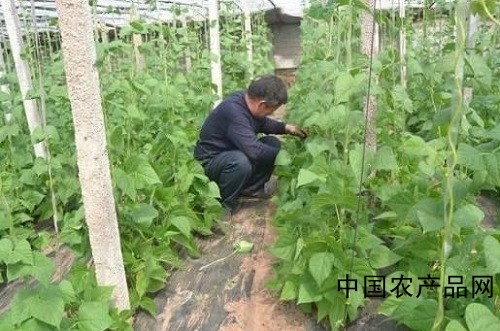[ Agricultural Products Network] Cowpea is rich in nutrients and is a popular vegetable . Kidney beans are resistant to high temperatures, hi light, drought-tolerant, and intolerant. In order to make the cowpeas in the morning market, it is easy to produce high-yield and high-yield. In spring, it is often cultivated in greenhouses. The following measures can be taken to promote early maturity: First, fertilizer management. The general principle is to prevent the stems and leaves from growing in the early stage and prevent the premature aging of the plants in the later stage. Generally, on the basis of applying the base fertilizer according to the standard, the seedling stage is topdressed 1-2 times according to the growth potential, and 750 kg of diluted manure water or 2.5 kg of urea per acre is applied; 3 times of flowering and pod filling period, the total content of each application 25% of NPK ternary compound fertilizer 10-15 kg. In the seedling stage, the water should be properly controlled to prevent the stems and leaves from growing and reducing the inflorescences. In the flowering and pod-forming period, more water is needed, and the water is poured once every 7 days. The harvesting period is combined with watering to apply fertilizer. The cowpeas cultivated in the facility have long flowering and pod-forming period, and should pay attention to the late-stage topdressing, and combined with the prevention of pests and diseases, the application of foliar fertilizers such as potassium dihydrogen phosphate and multi-boron fertilizer to prevent premature aging of plants. Second, lead vines. The cowpeas are long and vines are swift, and the plastic ropes are hanged on the scaffolding when the leaves are 5-6. The early stem vines are not strong enough to be wound around the vines, and they should be selected in the morning when the dew is not dry or cloudy to prevent the stems from breaking. Third, pruning. Combine with the vines for reasonable pruning. Generally, the side branches below the first inflorescence are removed to 3 cm to ensure that the main stem is thick; the lateral branches above the first inflorescence leave 1-2 toppings; when the main vines are to the top of the shed, topping Topping to control growth and promote the formation of flower buds in the lower lateral branches. Fourth, pest control . The main diseases of cowpea are rust, leaf spot and root rot; insect pests include pea pods, leaf miners and mites, and comprehensive control techniques should be adopted. Rust can be controlled by powder rust, leaf spot can be controlled by methyl thiophanate, root rot can be controlled by carbendazim, diclosan, and green bactericidal king. In addition to soil treatment, underground pests such as tigers can be used to mix and kill trichlorfon in the evening to be trapped around the field. The pea pods can be controlled by insecticidal double, yinbao and rui, and the leaf miner can be controlled by lesbian and phoxim. Magnetostrictive System Scaler A magnetostrictive system scaler is a dental instrument used for removing calculus and plaque from the teeth. It utilizes high-frequency vibrations generated by a magnetostrictive transducer to break down and remove the deposits from the tooth surface. Magnetostrictive System Scaler,Cavitron Type Scaler,Dentsply Type Scaler,Dental Magneto Scaler Rolence Enterprise Inc. , https://www.rolencedent.com
How to manage the early spring bean ripening?